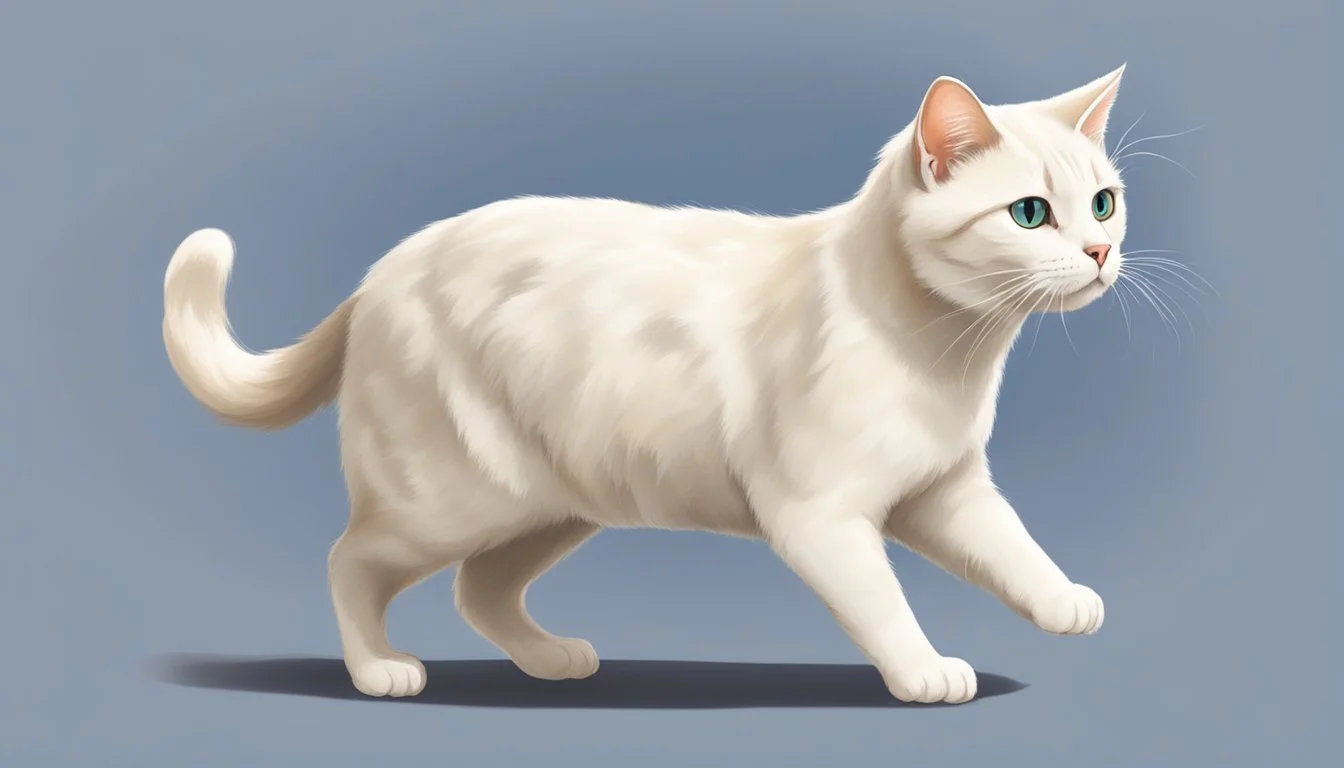Exploring the Connection Between Autism and Cats
Cats exhibit a wide range of behaviors that can sometimes perplex their owners. Some feline behaviors may appear similar to characteristics associated with autism in humans, leading to questions about whether cats can be autistic. While cats cannot have autism, they can display behaviors that resemble autism-like traits due to various health issues or environmental factors.
Feline behavior is complex and influenced by numerous factors, including genetics, early socialization, and overall health. Cats may show signs of anxiety, obsessive-compulsive disorder, or heightened sensitivity to stimuli, which can be mistaken for autism-like behaviors. These symptoms often stem from underlying medical conditions, such as kidney disease or diabetes, rather than a neurodevelopmental disorder like autism.
Understanding feline behavior requires careful observation and consideration of multiple factors. Cat owners concerned about their pet's unusual behaviors should consult a veterinarian to rule out any health issues and receive appropriate guidance for managing their cat's specific needs. With proper care and attention, cats exhibiting atypical behaviors can lead happy, healthy lives.
Understanding Autism
Autism spectrum disorder (ASD) is a complex neurodevelopmental condition that affects individuals differently. It impacts social interaction, communication, and behavior patterns.
Autism Spectrum Overview
Autism is a spectrum disorder, meaning it presents with varying degrees of severity and symptoms. It typically appears in early childhood and persists throughout life. ASD affects individuals of all ethnicities, races, and socioeconomic backgrounds.
The spectrum ranges from those who require substantial support to those who can live independently. Each person with autism has a unique set of strengths and challenges.
Signs and Symptoms of Autism
Signs of autism often emerge before age 3. Early indicators may include:
Delayed speech or language skills
Lack of eye contact
Limited facial expressions
Difficulty understanding others' emotions
Unusual reactions to sensory input (sounds, textures, lights)
Some children show signs from infancy, while others develop normally and then regress. Not all individuals with autism will display every symptom, and severity varies.
Social Interaction and Communication
People with autism often struggle with social skills and communication. Common challenges include:
Difficulty interpreting nonverbal cues
Trouble maintaining conversations
Literal interpretation of language
Preference for solitary activities
Challenges in forming friendships
Some individuals may appear uninterested in social interactions. Others may want to connect but lack the skills to do so effectively.
Repetitive Behaviors and Routines
Repetitive behaviors and adherence to routines are hallmark features of autism. These may manifest as:
Repetitive body movements (rocking, hand-flapping)
Intense focus on specific topics or objects
Rigid adherence to schedules or rituals
Distress when routines are disrupted
Unusual sensory interests or aversions
These behaviors can serve as coping mechanisms or sources of comfort for individuals with autism. They may also reflect a need for predictability and structure in their environment.
Cats and Autism
Cats and autism share intriguing connections, from behavioral similarities to potential therapeutic benefits. Research suggests cats may offer unique support for individuals on the autism spectrum.
Feline Behavior and Autism
Cats exhibit behaviors that sometimes resemble traits associated with autism spectrum disorders. They often prefer routine, show sensitivity to sensory stimuli, and engage in repetitive actions. Some cats display intense focus on specific objects or activities, mirroring the special interests common in autism.
Felines may struggle with social interactions, appearing aloof or anxious in unfamiliar situations. This parallels social challenges faced by many autistic individuals. Cats' independent nature and need for personal space can align with autistic preferences for solitude and controlled environments.
Importantly, these similarities do not imply cats are autistic. Rather, they highlight shared behavioral patterns that may contribute to the affinity between cats and people on the autism spectrum.
Autism in Cats: Fact or Misconception?
The concept of autism in cats is a common misconception. While cats can display behaviors reminiscent of autism, they do not develop this neurodevelopmental condition as humans do. Feline Autism Spectrum Disorder (FASD) is not a recognized veterinary diagnosis.
Behaviors mistaken for autism in cats often stem from other causes:
Anxiety disorders
Obsessive-Compulsive Disorder (OCD)
Medical conditions like kidney disease or diabetes
Sensory sensitivities
Lack of socialization
Veterinarians emphasize the importance of distinguishing between normal feline behavior, medical issues, and true behavioral problems. Cats' unique communication styles and social structures differ significantly from humans, making direct comparisons to autism inappropriate.
Animal Behaviorists' Insights
Animal behaviorists play a crucial role in understanding and addressing feline behavior issues. They stress the need for individualized assessment of each cat's behavior within its specific context. Factors such as environment, past experiences, and health status all influence a cat's actions.
Behaviorists note that while cats cannot be autistic, they can provide valuable companionship to individuals with autism. Cats' predictable routines and non-demanding social nature often create a comfortable, low-stress relationship. This can help reduce anxiety and improve social skills in autistic children and adults.
Experts recommend considering a cat's temperament when pairing them with autistic individuals. Calm, affectionate cats typically offer the most therapeutic benefits. Professional guidance can ensure successful human-feline bonds that support the well-being of both parties.
The Role of Companion Animals
Companion animals, especially cats, can provide significant benefits for individuals with autism. Feline companions offer unique support through their calming presence and ability to foster social connections.
Benefits of Feline Companions
Cats can help reduce stress and anxiety in autistic individuals. Their soft fur and gentle purring create a soothing sensory experience. This tactile interaction can be especially beneficial for those who struggle with touch sensitivity.
Feline companions also offer unconditional love and acceptance. They don't judge or have social expectations, which can be comforting for people with autism who may find human interactions challenging.
Cats can improve emotional regulation. Caring for a pet teaches responsibility and empathy, skills that can transfer to other areas of life.
Human-Autism and Feline Interaction
Cats facilitate social interaction for autistic individuals. They serve as a common topic of conversation, helping to break the ice in social situations.
Feline behavior can be more predictable and easier to interpret than human behavior. This can make interactions less stressful for people with autism.
Cats don't require constant attention, allowing autistic individuals to engage on their own terms. This flexibility supports autonomy and reduces social pressure.
Research suggests that cats can improve social behaviors in children with autism. The Feline Friends Study found positive outcomes when placing temperament-screened shelter cats with families of autistic children.
Creating a Comfortable Environment
A cat-friendly home can become a safe space for autistic individuals. Quiet areas with cat beds or perches allow for shared relaxation time.
Establishing routines around feeding and playtime can provide structure and predictability. This consistency can be calming for both cats and their autistic companions.
Sensory-friendly toys and scratching posts can create engaging experiences. These items offer opportunities for shared play and bonding without overwhelming stimulation.
Providing escape routes for the cat ensures they have control over interactions. This respect for boundaries can model healthy relationship dynamics.
Behavior and Sensory Sensitivities
Cats can exhibit behaviors and sensitivities that may resemble autism-like traits in humans. These feline characteristics often manifest as responses to environmental stimuli and stress management.
Cats' Responses to Sensory Stimuli
Cats possess heightened sensory perception, making them responsive to various stimuli in their environment. Some cats may display hypersensitivity to certain sounds, such as loud noises or high-pitched tones. This can result in stress behaviors like hiding or excessive grooming.
Touch sensitivity is another common trait. Some cats may become agitated when petted in specific areas or for extended periods. They might react by swatting or biting to communicate their discomfort.
Environmental factors like bright lights or strong odors can also trigger sensory responses in cats. These stimuli may cause them to avoid certain areas of the home or exhibit anxious behaviors.
Managing Stress and Anxiety
Recognizing and addressing stress in cats is crucial for their well-being. Creating a calm environment with safe spaces for retreat can help reduce anxiety. Providing hiding spots, elevated perches, and quiet areas allows cats to self-regulate their sensory input.
Consistent routines and predictable interactions can help minimize stress for sensitive cats. Gradual introduction to new experiences and positive reinforcement techniques can aid in desensitization.
Enrichment activities tailored to a cat's preferences can help manage anxiety. Interactive toys, puzzle feeders, and vertical spaces offer mental stimulation and physical outlets for stress relief.
Diagnosis and Treatment
Identifying autism-like behaviors in cats requires careful observation and professional assessment. Appropriate interventions and treatment plans can help manage symptoms and improve quality of life for affected felines.
Identifying Signs in Cats
Veterinarians look for specific behaviors when evaluating cats for autism-like symptoms. These may include:
Repetitive movements or vocalizations
Difficulty with social interactions
Unusual sensory sensitivities
Resistance to changes in routine
Cats exhibiting these signs undergo thorough physical exams to rule out other medical conditions. Behavioral assessments help distinguish autism-like traits from normal feline behavior.
Interventions and Behavior Modification
Tailored interventions can help cats with autism-like behaviors adapt to their environment. Common strategies include:
Creating a predictable daily routine
Providing a calm, structured living space
Using positive reinforcement techniques
Introducing environmental enrichment activities
Gradual exposure to new experiences can help reduce anxiety. Puzzle toys and interactive games stimulate mental engagement.
Professional Help and Treatment Plans
Veterinary behaviorists play a crucial role in diagnosing and managing feline autism-like behaviors. They develop personalized treatment plans that may include:
Behavior modification techniques
Environmental adjustments
Dietary changes
Medication in some cases
Regular follow-ups allow for plan adjustments as needed. Some cats benefit from anti-anxiety medications or supplements to manage stress. Collaboration between pet owners and professionals ensures the best outcomes for affected cats.
Supporting Autistic Individuals with Cats
Cats can provide valuable support for people with autism. These furry companions offer unique benefits that enhance daily life and skills development.
Enhancing Communication and Social Skills
Cats serve as non-judgmental companions for autistic individuals, fostering social interactions. Caring for a cat teaches empathy and compassion, crucial skills for building relationships. The simple act of petting a cat can trigger oxytocin release, promoting emotional bonding.
Cats encourage verbal and non-verbal communication. Autistic children often practice talking to their feline friends, improving language skills. Observing a cat's body language helps develop understanding of non-verbal cues.
Feline companionship can reduce anxiety in social situations. This increased comfort may extend to interactions with people, boosting confidence in social settings.
Routine and Predictable Environments
Cats thrive on consistent routines, aligning well with the needs of many autistic individuals. Feeding, grooming, and playtime create a structured daily schedule, providing a sense of stability and predictability.
Caring for a cat promotes independence through manageable tasks. These responsibilities offer opportunities for positive reinforcement, building self-esteem and life skills.
Cats adapt well to quiet, controlled environments often preferred by those with autism. Their calm presence can help reduce sensory overload and create a soothing atmosphere at home.
Regular interactions with a cat can establish a comforting ritual, easing transitions between activities or coping with changes in routine.
Myth Busting: Cats with Autism
Misinformation about feline autism has spread widely, leading to confusion among cat owners. Let's examine the facts and address common misconceptions about this topic.
Separating Fact from Fiction
Cats cannot have autism. Autism is a neurodevelopmental condition specific to humans. While cats may exhibit behaviors that resemble autism-like traits, these are not indicative of feline autism.
Repetitive behaviors or sensitivity to loud noises in cats are often related to their individual personalities or responses to their environment. Health issues, anxiety, or obsessive-compulsive disorder (OCD) can also cause behaviors that might be mistaken for autism-like traits.
Some cat breeds, like Siamese, may display increased vocalization or attention-seeking tendencies. These characteristics are breed-specific and not related to autism.
Addressing Common Misconceptions
A common misconception is that cats can be diagnosed with autism. No scientific research supports this claim. Behaviors interpreted as autistic in cats have simpler explanations.
Genetic and environmental factors play roles in feline behavior, but they do not cause autism in cats. Sensitivity to stimuli or social difficulties in cats often stem from other causes:
Anxiety or stress
Medical conditions (e.g., kidney disease, diabetes)
Lack of socialization
Past trauma
It's crucial to consult a veterinarian if a cat displays unusual behaviors. Proper diagnosis and treatment can address underlying issues and improve the cat's quality of life.
Advancements in Research
Recent studies have explored the potential benefits of cats for individuals with autism spectrum disorder (ASD). Researchers are investigating both feline therapy and neurological treatments to improve social skills and reduce symptoms.
Current Studies on Autism and Cats
A scoping review has compiled knowledge on feline therapy in autism, providing a foundation for further targeted research. This review highlights the role cats can play in supporting individuals with ASD.
Studies have shown that cat adoption in families with autistic children may lead to increased empathy and improved social skills. The Human Animal Bond Research Institute (HABRI) published findings demonstrating positive impacts on children's social abilities and anxiety levels.
Researchers are examining how cats, despite their reputation for independence, can help children with autism. This work aims to better understand the human-animal bond and its therapeutic potential.
Future Directions in Autism Research
Ongoing research focuses on developing practical clinical approaches and treatments for immediate implementation. Scientists are exploring genetics, biomarkers, and medication development to address autism and co-occurring conditions.
A promising area of investigation involves pressure chamber therapy. Recent studies have shown neurological improvements, including decreased inflammation and increased brain functionality in autism animal models.
Researchers are also emphasizing the importance of incorporating autistic perspectives in clinical autism research. This approach ensures that future studies address the most pressing needs of individuals with ASD.
Fostering a Therapeutic Relationship
Creating a supportive environment is crucial for both cats and individuals with autism. Proper enrichment and tailored strategies can enhance the bond between them, promoting emotional well-being and learning opportunities.
Environment Enrichment for Cats
Cats thrive in stimulating environments. Provide scratching posts, climbing trees, and interactive toys to keep them engaged. Offer hiding spots like cardboard boxes or cozy beds for security.
Create vertical spaces with shelves or cat towers. This allows cats to observe their surroundings from a safe vantage point, reducing stress.
Rotate toys regularly to maintain interest. Puzzle feeders can stimulate their minds and natural hunting instincts. Set aside daily play sessions to strengthen the bond between the cat and its human companion.
Supportive Strategies for Autistic Individuals
Establish a predictable routine for cat care activities. This can include feeding times, play sessions, and grooming. Visual schedules or timers may help autistic individuals track these tasks.
Create a quiet, low-sensory area for cat interactions. This safe space allows for comfortable bonding without overwhelming stimuli.
Encourage gentle touch and calm interactions. Demonstrate proper petting techniques and respect the cat's boundaries. This teaches important social skills and empathy.
Use clear, concrete language when discussing cat care. Break tasks into small, manageable steps. Positive reinforcement can boost confidence in caring for the cat.





